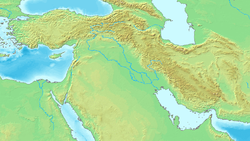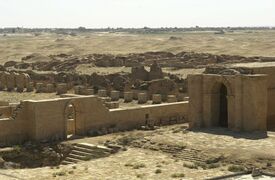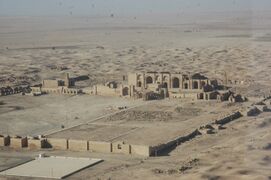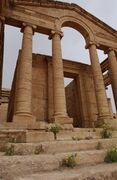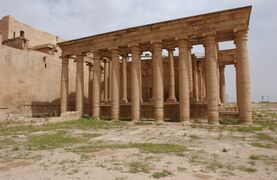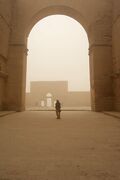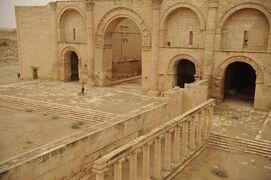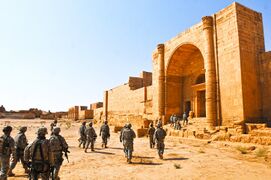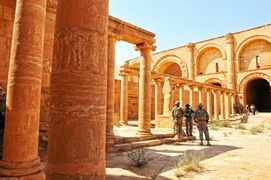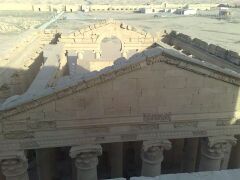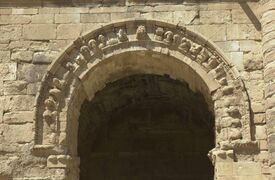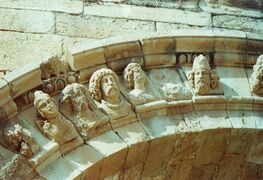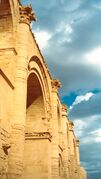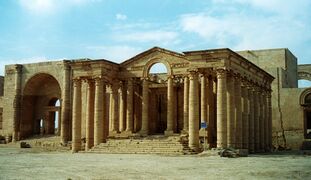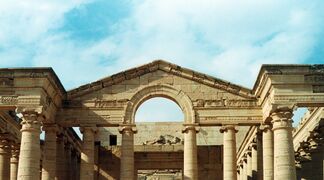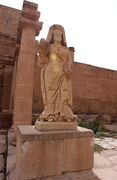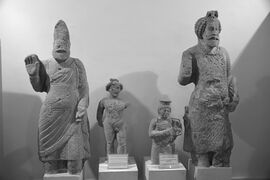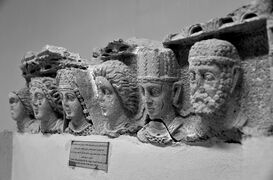مدينة الحضر
الحضر | |
 The effects of Hatra in 2019 | |
| الاسم البديل | al-Ḥaḍr |
|---|---|
| المكان | Hatra District, Nineveh Governorate, Iraq |
| المنطقة | Mesopotamia |
| الإحداثيات | 35°35′17″N 42°43′6″E / 35.58806°N 42.71833°E |
| النوع | Settlement, temple |
| المساحة | 300 ha (740 acre) |
| التاريخ | |
| تأسس | 3rd or 2nd century BC |
| هـُـجـِر | 241 AD |
| الثقافات | Arab, Mesopotamian, Parthian |
| ساتل لـ | Parthian Empire |
| ملاحظات حول الموقع | |
| الحالة | Ruins |
| الاتاحة للعامة | Inaccessible (in a war zone) |
| الاسم الرسمي | Hatra |
| النوع | Cultural |
| المعيار | ii, iii, iv, vi |
| التوصيف | 1985 (9th session) |
| الرقم المرجعي | 277 |
| Region | Arab States |
الحضر هي مدينة عربية تاريخية تقع على بعد 80 كم جنوب الموصل. يعتقد أن المدينة أسست في بداية القرن الثاني قبل الميلاد. عرفت مملكة الحضر بهندستها المعمارية وفنونها وأسلحتها وصناعاتها,الحضر كانت في مستوى روما من حيث التقدم حيث وجد فيها حمامات ذات نظام تسخين متطور وأبراج مراقبة ومحكمة ونقوش منحوته وفسيفساء وعملات معدنية وتماثيل.
شعار المدينة هو الصقر, وهو يمثل قوة وهيبة المدينة التي يحكمها آل نصر الأقوياء. اشتهرت الحضر في زمن جذيمة الوضّاح الأبرش والذي اغتالته الزباء ملكة تدمر. كان سكان الحضر وثنيون يعبدون آلهه منها اللات و شمش "الشمس" ثم تنصرو وغدت دولتهم دولة دينية تحكم بحكم ديمقراطي حيث يحق للكل إبداء رأيه. وقد حكمت الحضر عدت ملكات وجدت تماثيلهم وهذا يدل على المساواة بين الرجل والمرأة في مجتمعهم. وكان للحضر ميزة تجارية حيث ان موقعها يعتبر ملتقى القوافل حيث يربط بين الجزيرة العربية والخليج العربي إلى الشام والبحر الأحمر.
وجدت كتابة على أحد المباني تقول:"سنطروق هو ملك العرب". وسنطروق يسمى في التاريخ العربي بالساطرون المشهور بقصة خيانة ابنته له. حاول الفرس والرومان غزوها مرارا حيث فشل الإمبراطور الروماني تراجان وكذلك الإمبراطور الروماني سيبتيموس سيفيروس عام 199م بعد ان احتل كلاً من بابل وسلوقية و تيسفون أن سكانها دافعوا عنها دفاعاً عنيداً, و أنهم استخدموا أقواساً مركبة ترمي سهمين مرة واحدة و أنهم قتلوا بها بعضاً من الحرس الوطني الخاص بالامبراطور. وهزمت جيش الإمبراطور الفارسي أردشير الأول الذي سيطرة على منطقة الجزيرة كلها حتى سقطت بيد الفرس و العرب عام 241م ودمرت تدميرا شديد ومنع أهلها من حمل السلاح. وكانت تلك نهايتها.
الاسم
الحضر معروفة باسم (الحضر) في اللغة العربية. تم تسجيلها على أنها ḥṭrʾ 𐣧𐣨𐣣𐣠 (Ḥaṭrā) في نقوش حتران الآرامية، والتي تعني على الأرجح "السور، السياج". في السريانية، تُسجَّل عادةً بصيغة الجمع Ḥaṭrē. في الأعمال الرومانية، تم تسجيلها باليونانية Átra واللاتينية Hatra and Hatris.[1]
كانت المدينة تسمى رسمياً بيت الإله 𐣡𐣩𐣵 𐣠𐣫𐣤𐣠 "، في نقوش حتران الآرامية[2] وتم تسجيلها مرة واحدة باسم "ضميمة شمش" (ḥtrʾ d-šmš 𐣧𐣨𐣣𐣠 𐣣𐣴𐣬𐣴) على عملة معدنية.[1]
التاريخ
لا توجد معلومات أثرية عن المدينة قبل الفترة البارثية ولكن من المحتمل أن يعود تاريخ الاستيطان في المنطقة إلى العصر السلوقي على الأقل.[1] ازدهرت مدينة الحضر في ظل البارثيين، خلال القرنين الأول والثاني بعد الميلاد، كمركز ديني وتجاري.[3] في وقت لاحق، أصبحت المدينة عاصمة ربما أول مملكة عربية في سلسلة المدن العربية الممتدة من الحضر، في الشمال الشرقي، عبر تدمر، وبعلبك والبتراء، في الجنوب الغربي. كانت المنطقة التي يسيطر عليها الحضر هي مملكة الحضر، وهي مملكة عازلة شبه مستقلة على الحدود الغربية للإمبراطورية البارثية، يحكمها أمراء عرب.
أصبحت الحضر مدينة حدودية محصنة مهمة ولعبت دور مهم في الحرب البارثية الثانية، حيث صمدت أمام الهجمات المتكررة من قبل الإمبراطورية الرومانية. خلال القرن الثاني الميلادي ، صدت المدينة حصار كل من تراجان (116/117) وسپتيميوس سڤروس (198/199).[4] هزمت قوات الحضر الصاعد من الفرس الساسانيين عام 238 في معركة شهرزور، لكنها سقطت بعد فترة وجيزة عام 241 في أيدي جيش الملك الساساني شابور الأول وتم تدميرها.[4] تحكي القصص التقليدية لـ سقوط الحضر عن النادرة، ابنة ملك عربة التي خانتها المدينة في يد شابور لأنها وقعت في حبه. تروي القصة كيف قتلت شابور الملك وتزوجت من نادرة، لكنها قتلت أيضاً فيما بعد بعد أن أدركت جحودها تجاه والدها.[3][5]
Hatra was the best preserved and most informative example of a Parthian city. Its plan was circular,[6] and was encircled by inner and outer walls nearly 2 كيلومتر (1.2 mi) in diameter[7] and supported by more than 160 towers. A temenos (τέμενος) surrounded the principal sacred buildings in the city's centre. The temples covered some 1.2 hectares and were dominated by the Great Temple, an enormous structure with vaults and columns that once rose to 30 metres. The city was famed for its fusion of Greek, Mesopotamian, Canaanite, Aramean and Arabian pantheons, known in Aramaic as Beiṯ Ĕlāhā ("House of God"). The city had temples to Nergal (Assyrian-Babylonian and Akkadian), Hermes (Greek), Atargatis (Syro-Aramaean), Allat, Shamiyyah (Arabian), and Shamash (the Mesopotamian sun god).[3] Other deities mentioned in the Hatran Aramaic inscriptions were the Aramaean Ba'al Shamayn, and the female deity known as Ashurbel, which was perhaps the assimilation of the two deities the Assyrian god Ashur and the Babylonian Bel—despite their being individually masculine.
قائمة الحكام
في النقوش الموجودة في الحضر، تم ذكر العديد من الحكام. تم ذكر الحكام الآخرين بشكل متقطع من قبل المؤلفين الكلاسيكيين. أطلق على الحكام الأوائل اسم "مارجي" ("ماريا")، وأطلق على الحكام الأوائل لقب "ملك العرب"، و"ملكا"، و"ملك".[1]
| Name | Title | Date | Portrait | Note | |
|---|---|---|---|---|---|
| 1 | Worod | mry´ | |||
| 2 | Ma’nu | mry´ | |||
| 3 | Elkud | mry´ | 155/156 | ||
| 4 | Nashrihab | mry´ | 128/29 - 137/38 AD | ||
| 5 | Naṣru | mry´ | 128/29 - 176/77 | ||
| 6 | Wolgash I | mry´ and mlk | The two brothers may have been co-rulers. | ||
| 7 | سنطروق الأول | mry´ and mlk | 176/177 | ||
| 8 | عبد سميع | mlk | 192/93 - 201/202 | Supported the Roman emperor Pescennius Niger | |
| 9 | سنطروق الثاني | mlk - King | 207/08 - 229/230 | Became a vassal of the Romans under Gordian III during Roman-Persian Wars | |
فن الحضر
وفقًا لـ جون إم روزنفيلد، تنتمي تماثيل الحضر إلى المجال الثقافي الپارثي، مع العديد من أوجه التشابه من حيث الملابس أو العناصر الزخرفية أو الوضع، والتي تميل إلى أن تكون ضخمة وأمامية، مع القدمين مفلطحة في كثير من الأحيان.[8] يُنظر إلى هندسة الحضر نفسها عموماً على أنها مثال على العمارة البارثية.[8] يمكن رؤية أوجه التشابه مع Art of the Kushans أيضاً، إما بسبب التبادل الثقافي المباشر بين منطقة بلاد ما بين النهرين وامبراطورية كوشان في ذلك الوقت، أو من أحد الفنانين البارثيين الشائعين الخلفية التي تؤدي إلى أنواع مماثلة من التمثيل.[8]
قائد عسكري من مدينة الحضر. متحف العراق، بغداد.
إغاثة الرب نرگال من الحضر.
مدينة الحضر الحديثة
Hatra was used as the setting for the opening scene in the 1973 film The Exorcist,[9] and since 1985 has been a UNESCO World Heritage Site.[10]
The site was first surveyed by Walter Andrae of the German excavation team working in Assur from 1906 to 1911. But systematic excavations have been undertaken only from 1951 by Iraqi archeologists. From the 1980s, the Italian Archaeological Expedition,[11] directed by R. Ricciardi Venco (University of Turin), made major discoveries at Hatra. The excavations were focused on an important house ("Building A"[12]), located close to the Temenos, and on deep soundings in the Temenos central area.[13] Now the Expedition is active in different projects regarding the preservation and development of the archaeological site.[14] In 1990, a Polish expedition of the Polish Centre of Mediterranean Archaeology University of Warsaw recorded and studied the city's defense walls.[15] The team was directed by Michał Gawlikowski (PCMA UW).[16]
In 2004, The Daily Telegraph stated "Hatra's finely preserved columns and statues make it one of the most impressive of Iraq's archaeological sites"[17]
استعادة صدام حسين
رأى صدام حسين أن تاريخ بلاد ما بين النهرين يعكس مجد نفسه، وسعى لاستعادة الموقع، وآخرين في نينوى ونمرود و آشور وبابل كرمز للإنجاز العربي،[18] إنفاق أكثر من 80 مليون دولار أمريكي في المرحلة الأولى لترميم بابل. طالب صدام حسين أن تستخدم قوالب الطوب الجديدة في الترميم اسمه (تقليدًا لـ نبوخذ نصر) وأجزاء من أحد المعابد المرممة في الحضر تحمل اسم صدام.[19]
تدمير داعش
Actions by the Islamic State of Iraq and the Levant, which occupied the area in mid-2014, have been a major threat to Hatra. In early 2015 they announced their intention to destroy many artifacts, claiming that such "graven images" were un-Islamic, encouraged shirk (or polytheism), and could not be permitted to exist, despite the preservation of the site for 1,400 years by various Islamic regimes. ISIL militants pledged to destroy the remaining artifacts. Shortly thereafter, they released a video showing the destruction of some artifacts from Hatra.[20][21] After the bulldozing of Nimrud on March 5, 2015, "Hatra of course will be next" said Abdulamir Hamdani, an Iraqi archaeologist from Stony Brook University.[22] On March 7, Kurdish and Iraqi official sources reported ISIS had begun the demolishing the ruins of Hatra.[23][24] A video released by ISIL during the next month showed the destruction of the monuments.[25]
UNESCO and ISESCO issued a joint statement saying "With this latest act of barbarism against Hatra, (the IS group) shows the contempt in which it holds the history and heritage of Arab people."[26]
The pro-Iraqi government Popular Mobilization Forces captured the city on 26 April 2017.[27] A spokeswoman for the militias stated that ISIL had destroyed the sculptures and engraved images of the site, but its walls and towers were still standing though contained holes and scratches received from ISIL bullets. PMF units also stated that the group had mined the site's eastern gates, thus temporarily preventing any assessment of damage by archaeologists.[28] It was reported on 1 May that the site had suffered less damage than feared earlier. A journalist of EFE had earlier reported finding many destroyed statues, burnt buildings as well as signs of looting. Layla Salih, head of antiquities for Nineveh Governorate, stated that most of the buildings were intact and the destruction didn't compare with that of other archaeological sites of Iraq. A PMF commander also stated that the damage was relatively minor.[29]
معرض الصور
American soldiers at the site, September 2010
American soldiers at the site, September 2010
View of iwans
Door lintel from Hatra. 2nd-3rd century AD. Sulaymaniyah Museum, Iraqi Kurdistan
المناخ
الحضر لديها مناخ شبه قاحل حار (تصنيف كوپن للمناخ). يسقط معظم المطر في الشتاء. يبلغ المعدل السنوي لدرجات الحرارة في مدينة الحضر 20.7 درجة مئوية (69.3 درجة فهرنهايت). حوالي 257 م (0.84 قدم) من الأمطار تهطل سنوياً.
| بيانات المناخ لـ Hatra (Al Hadar) | |||||||||||||
|---|---|---|---|---|---|---|---|---|---|---|---|---|---|
| الشهر | ينا | فب | مار | أبر | ماي | يون | يول | أغس | سبت | أكت | نوف | ديس | السنة |
| متوسط القصوى اليومية °س (°ف) | 12.8 (55.0) |
15.8 (60.4) |
19.8 (67.6) |
25.3 (77.5) |
33.0 (91.4) |
39.0 (102.2) |
42.3 (108.1) |
42.1 (107.8) |
37.9 (100.2) |
31.0 (87.8) |
22.5 (72.5) |
14.8 (58.6) |
28.0 (82.4) |
| متوسط الدنيا اليومية °س (°ف) | 3.2 (37.8) |
4.6 (40.3) |
7.6 (45.7) |
11.7 (53.1) |
17.3 (63.1) |
21.8 (71.2) |
24.8 (76.6) |
24.1 (75.4) |
19.7 (67.5) |
14.3 (57.7) |
8.8 (47.8) |
4.1 (39.4) |
13.5 (56.3) |
| متوسط تساقط الأمطار mm (inches) | 43 (1.7) |
39 (1.5) |
49 (1.9) |
36 (1.4) |
13 (0.5) |
0 (0) |
0 (0) |
0 (0) |
0 (0) |
8 (0.3) |
25 (1.0) |
44 (1.7) |
257 (10.1) |
| Source: climate-data | |||||||||||||
مقالات ذات صلة
- أرامية الحضر
- تدمر
- المناذرة
- الغساسنة
- طق كسرة، تقاسم الميزات المعمارية مع الهياكل في الحضر
المصادر
- ^ أ ب ت ث Schmitt, Rüdiger. "HATRA". iranicaonline.org. Encyclopaedia Iranica. Retrieved 16 March 2019.
- ^ "Hatra | ancient city, Iraq". Encyclopedia Britannica (in الإنجليزية). Retrieved 2020-12-25.
- ^ أ ب ت "Hatra". Encyclopædia Britannica. Retrieved 14 December 2013.
- ^ أ ب Advisory Body Evaluation on Hatra. International Council on Monuments and Sites (ICOMOS). 1985. pages 1–2.
- ^ E.J. Brill's First Encyclopaedia of Islam 1913–1936 (in الإنجليزية). BRILL. 1987. p. 207a. ISBN 9789004082656.
- ^ Salma, K. Jayyusi; Holod, Renata; Petruccioli, Attilio; André, Raymond (2008). The City in the Islamic World. Leiden: Brill. p. 174. ISBN 9789004162402.
- ^ "Hatra UNESCO World Heritage Centre". whc.unesco.org/en. UNESCO. 1992–2015. Retrieved 31 March 2015.
- ^ أ ب ت Rosenfield, John M. (1967). The Dynastic Arts of the Kushans (in الإنجليزية). University of California Press. pp. 170–173.
- ^ Freeman, Colin s (25 June 2014). "Iraq's 'Exorcist' temple falls into Isis jihadist hand". The Telegraph. London. Retrieved 7 March 2015.
- ^ "Hatra". whc.unesco.org. UNESCO. Retrieved 7 March 2015.
- ^ Hatra – Italian Archaeological Expedition
- ^ "L'Edificio A". Hatra – Italian Archaeological Expedition (in الإيطالية). 2016-11-25. Retrieved 2020-07-25.
- ^ "I sondaggi del Temenos". Hatra – Italian Archaeological Expedition (in الإيطالية). 2016-11-25. Retrieved 2020-07-25.
- ^ "Progetti/ Projects". Hatra – Italian Archaeological Expedition (in الإيطالية). 2016-12-10. Retrieved 2020-07-25.
- ^ Gawlikowski, Michał (1991). "The first season of excavations in Hatra, Iraq" (PDF). Polish Archaeology in the Mediterranean. 2.
- ^ "Hatra". pcma.uw.edu.pl. Retrieved 2020-07-08.
- ^ Freeman, Colin (4 January 2004). "American troops launch 'Exorcist' tour at ancient temple". The Telegraph.
- ^ Lawrence Rothfield (1 Aug 2009). The Rape of Mesopotamia: Behind the Looting of the Iraq Museum. University of Chicago Press. ISBN 9780226729435.
- ^ "Ancient Hatra Ruins". Defense Video & Imagery Distribution System. 9 September 2006.
- ^ Cockburn, Patrick (27 February 2015). "Iraq: Isis militants pledged to destroy remaining archaeological treasures in Nimrud". The Independent. Retrieved 8 March 2015.
- ^ "ISIL video shows destruction of 7th century artifacts". aljazeera.com. 26 February 2015. Retrieved 7 March 2015.
- ^ Karim Abou Merhi (5 March 2015). "IS 'bulldozed' ancient Assyrian city of Nimrud, Iraq says". AFP. Retrieved 5 March 2015.
- ^ Yacoub, Sameer N. (7 March 2015). "IS destroying another ancient archaeological site in Iraq". Army Times. United States. Associated Press. Retrieved 7 March 2015.
- ^ "Islamic state 'demolish' ancient Hatra site in Iraq". BBC. 7 March 2015. Retrieved 7 March 2015.
- ^ Vivian Salama (4 Apr 2015). "Video: Islamic State group shot, hammered away Iraq's Hatra". Associated Press.
- ^ Yacoub, Sameer N.; Salam, Vivian (7 March 2015). "IS destroying another ancient site in Iraq". The Telegraph. Macon, Georgia. Archived from the original on 10 March 2015. Retrieved 8 March 2015.
- ^ "Iraqi forces retake damaged Hatra heritage site from IS". Deutsche Welle. 26 April 2017. Retrieved 29 April 2017.
- ^ Hussain, Rikar (27 April 2017). "Iraqi Militias Find Relics Destroyed by IS in Ancient Town". Voice of America. Retrieved 29 April 2017.
- ^ "Hatra: IS damage to ancient Iraqi city less than feared". BBC News. 1 May 2017. Retrieved 1 May 2017.
للإستزادة المراجع
- Pages using gadget WikiMiniAtlas
- CS1 الإيطالية-language sources (it)
- Short description is different from Wikidata
- Articles containing explicitly cited عربية-language text
- Coordinates on Wikidata
- Articles containing لاتينية-language text
- مدن تاريخية
- مواقع أثرية في العراق
- مواقع التراث العالمي في العراق
- ممالك عربية
- تاريخ الشرق الأوسط
- تاريخ العرب
- آثار عربية
- مدن محافظة نينوى

